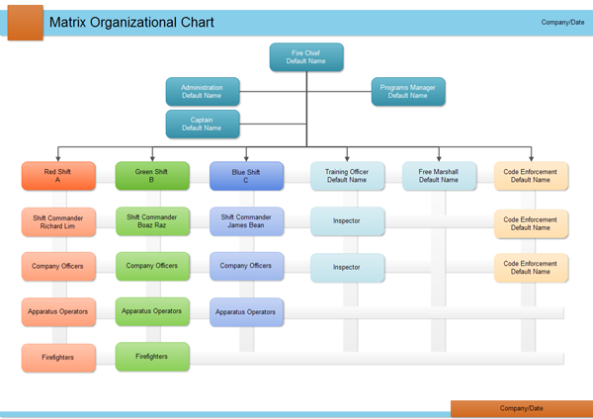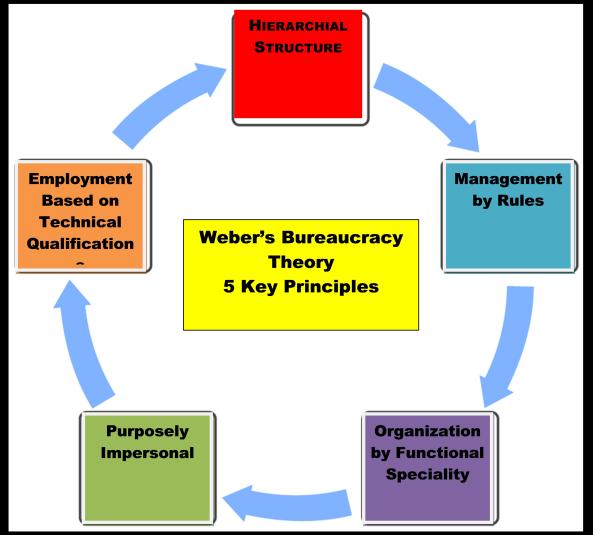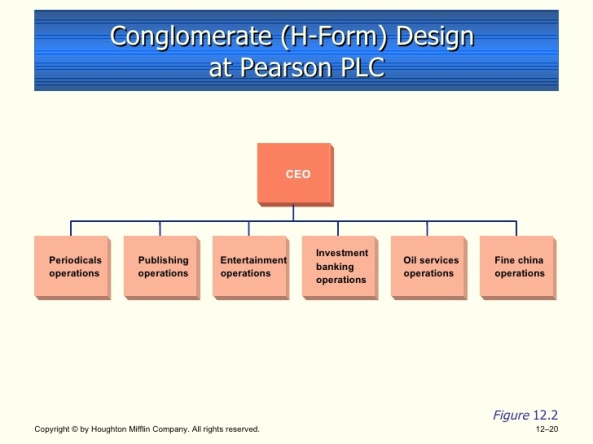Managing Organization Design
Nature of Organization Design
Organizational design is the overall set of structural elements of organization structure. Thus, organization design is a means to implement strategies and plans to achieve organizational goals (Griffin, 2011).
There are two models for organizational design: Bureaucratic and Behavior.
1. The Bureaucratic Model was pioneered by German Sociologist Max Weber and suggests that a bureaucracy is a model of organization design based on a legitimate and formal system of authority (Griffin, 2011).
Weber noted that there were 5 Key Principles to the Bureaucracy Model
Hierarchical Structure means that each level controls the level below and is also controlled by the level above. For Example, the Vice President is controlled by the Chief Executive Office and at the same time the VP controls the managers under him/her.
Management by Rules means that the rules allow decisions made a higher levels to be executed consistently to lower levels.
Organization by Functional Speciality means that work is done by specialities and people are organized into business units based on they type of work they do or the skills they have. For Example, at Target Corporation individuals are placed in the Marketing Business Units often based on their education, interests, and skills.
Purposely Impersonal means that a manager is expected to treat all employees equally and all customers equally. For example, a manager cannot promote an employee because they have become friends outside of work.
Employment Based on Technical Qualificationsthat an individual is hired on their qualifications rather than on any personal connections or relationships they may have.
2. Behavioral Mode: A model of organization design consistent with the human relations movement, stressing attention to developing work groups and concern with interpersonal processes (Griffin, 2011).
Strategy & Organization Design (3 Levels)
Corporate and business strategies both affect organization design. Basic organizational functions such as finance and marketing can also affect organization design in some cases (Griffin, 2011).
The 5 Competitive Forces that Shape Strategy: http://freevideolectures.com/Course/2526/Strategy/5#embed
1. Corporate Level: a strategy that recognizes the factors that are currently affecting the firm and its competitors and the factors that may affect the firm and its competitors in the future. The firm develops policies and practices to establish a new and creative role that will address those factors, giving the firm the competitive advantage.
Resource: _Corporate Level Strategy: http://youtu.be/aku1HUmJzDY
Corporate Level
-

Corporate strategies are developed at the highest levels of the organization.
At the corporate level, strategies are generally developed with the intent to align business practices with the organization’s mission statement. The mission statement is a document of why the organization is in business, how it will do business and for what reasons. Corporate level strategies influence the entire organization. The main focus of leaders at the corporate level is to enhance stakeholder value by developing the organization in accordance with its mission statement.
Read more: Difference Between Corporate Level Strategy & Business Level Strategy | eHow.com http://www.ehow.com/info_7829547_difference-strategy-business-level-strategy.html#ixzz24ORAlXE6
2. Business Level: Business-level strategies affect the design of individual businesses within the organization as well as the overall organization itself.
Resource: http://www.albany.edu/faculty/ja0754/bmgt481/lecture4.html
Business Level
-

Business level strategies are tasked with providing superior positioning within the industry. The main priority of business level strategies is to develop a sustainable competitive advantage. Leaders at the business level are primarily concerned with building and maintaining superior positioning within the industry in which the organization does business. Pricing and product differentiation are common features of business level strategies. For example, strategies must be implemented to provide value to consumers at an accessible price. Business level strategies are also concerned with creating a recognizable brand and marketing individual products.
Read more: Difference Between Corporate Level Strategy & Business Level Strategy | eHow.com http://www.ehow.com/info_7829547_difference-strategy-business-level-strategy.html#ixzz24OQheAgV
Because technology, environment, size, life cycle, and strategy can all influence organization design, it should come as no surprise that organizations adopt many different kinds of designs (Griffin, 2011).
More specifically, Organization Design is a formal, guided process for integrating the people, information and technology of an organization. It is used to match the form of the organization as closely as possible to the purpose(s) the organization seeks to achieve. Through the design process, organizations act to improve the probability that the collective efforts of members will be successful. (http://www.inovus.com/organiza.htm)
1. Functional (U-Form) Design
Groups positions into work units based on similar activities, skills, expertise, and resourses. For example, the chart below is an example of this structure, there is the head of the organization which represented by the President, under the him are 3 separate departments; Finance, Customer Relations, and Human Resources. Under each of these units are activities that are specific to these catagories and employees that have skills geared to these areas as well.
2. Conglomerate (H-form) Design
Conglomerate organizations are corporations that have multiple revenue streams from business activities that are completely unrelated (http://www.ehow.com/how_5542023_form-conglomerate-organizational-chart.html).
This means that an organization has several different businesses but they are not related to one another and therefore each individual manager is responsible for their business units profits or loses. The chart below is an example of an H-Form orgizational breakdown.
Resource:http://www.slideshare.net/slideshow/embed_code/2813217
3. Divisional (M-Form) Design
Because managers in large companies may have difficulty keeping track of all their company’s products and activities, specialized departments may develop. These departments are divided according to their organizational outputs (http://www.cliffsnotes.com/study_guide/Five-Approaches-to-Organizational-Design.topicArticleId-8944,articleId-8882.html)
Similar to the H-Form but the difference is that the departments are related and work together to achieve the organizations strategies. The M-Form example below is an example of a firm specializing in mechanical contracting.
4. Matrix Design
Matrix structure combines functional specialization with the focus of divisional structure (http://www.cliffsnotes.com/study_guide/Five-Approaches-to-Organizational-Design.topicArticleId-8944,articleId-8882.html)
Matrix management is a technique of managing an organization (or, more commonly, part of an organization) through a series of dual-reporting relationships instead of a more traditional linear management structure. In contrast to most other organizational structures, which arrange managers and employees by function or product, matrix management combines functional and product departments in a dual authority system. (http://www.referenceforbusiness.com/encyclopedia/Man-Mix/Matrix-Management-and-Structure.html)
Below is an example of Matrix Organizational Chart.

Read more: Matrix Management and Structure – duties, benefits http://www.referenceforbusiness.com/encyclopedia/Man-Mix/Matrix-Management-and-Structure.html#ixzz24cJw5bqW
5. Hybrid Design
Some organizations use a design that represents a hybrid of two or more of the common forms of organization design (Griffin, 2011). As it already mentioned the H-Form and M-Form of Organizational design are similiar and therefore an organization may chose to incorporate both into their structure.
Resource: http://www.ehow.com/list_6807181_advantages-hybrid-organizational-structures.html
Click on any of the links below to explore the many different aspects of Organizing in Management.
Elements of Organizing
Managing Organization Change
Human Resource and Organization






